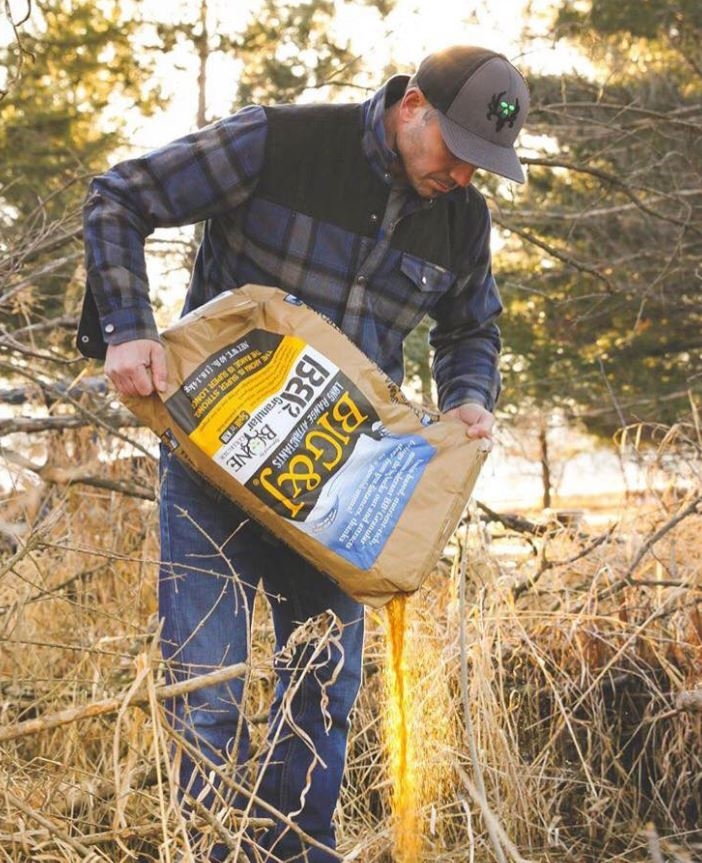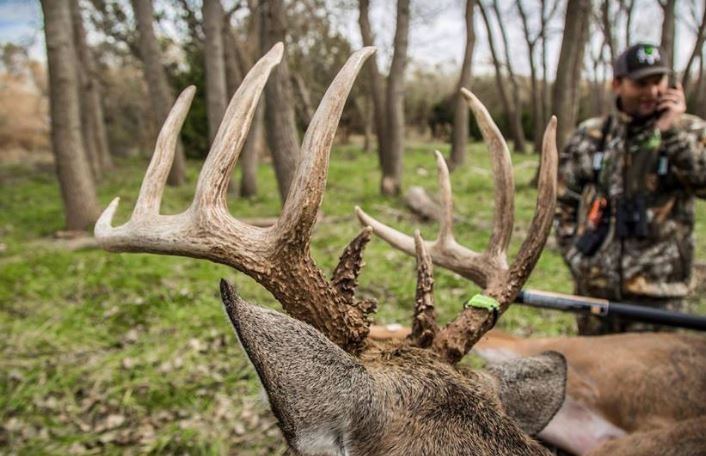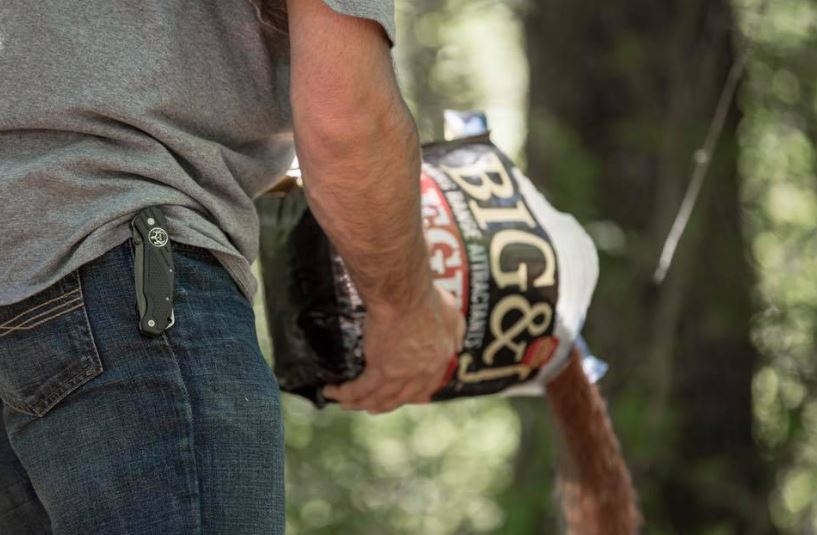Best Bulk Deer Feed for Axis Deer
Are You Using Deer Minerals and Feed on Your Property?
If you are lucky enough to hunt on private land, there's a very good chance you already use deer minerals or deer feed at some point throughout the year. And you really should be using this powerful combination if it is legal where you hunt. Why? Providing feed and mineral sites for deer are both important and relatively simple things you can do if you care about managing your property, the habitat, and the whitetails that call it home. When you combine them with other habitat management efforts, food plots or orchards , and good hunting practices, you can really turn a property into an amazing hunting location within a few years. In this ultimate guide, we'll show you the what, where, when, why, and how of deer minerals and feed.
But first, we'll tackle the legal and deer health disclaimers. It is illegal in some states to provide minerals and/or feed to deer at any point throughout the year. In other states, it may be legal to provide feed or a mineral lick for deer, but you cannot hunt that location until the attractant is gone and a certain timeframe has passed. Most states have these restrictions in place because they are concerned about the spread of certain fatal diseases, such as chronic wasting disease (CWD). Deer attractants are by definition, very attractive to deer and tend to concentrate them in close quarters. This can produce a lot of nose-to-nose interaction and it is believed that bodily fluids (e.g., saliva, urine, etc.) are the primary cause of spreading the disease. In fact, researchers at the University of Wisconsin-Madison recently discovered that CWD prions may even show up in the soil and water around heavily-used mineral licks. Because of all the complexities involved, please make sure you study your state's hunting regulations or reach out to a conservation officer to be absolutely sure. You don't want a simple misunderstanding to compromise your ability to hunt in the future!
Everything You Wanted to Know About Deer Minerals
It seems everyone these days uses some kind of minerals for deer, yet most people assume that any mineral or salt block is good enough to grow trophy bucks. That's just not the case. To grow mature bucks with impressive headgear, you need to provide food and shelter and let them get older. If you can't do those things, providing minerals probably won't produce those dreams, although it will still help individual deer. Here's what you should know about deer minerals.

Seasonal Deer Mineral Needs
As with nutritional/caloric needs (see the section below), a deer's need for minerals changes throughout the year too. The spring and summer are the most critical times of year for deer to get enough minerals in their system, while fall and winter don't offer as much of a benefit. In the spring and summer, deer primarily eat lush green vegetation that is high in water content. Deer need to maintain the minerals and salts in their bodies when they're consuming so much water. Because of that, many hunters easily see the connection between deer and salt and start buying cattle mineral blocks for deer. That will certainly attract them, but it's not providing the other essential deer minerals for antler growth .
Antlers are composed of primarily proteins during the growing phase, but they obviously also have minerals in them – they are bone after all. Once the antlers harden in the late summer, they are roughly half protein and half minerals, according to the QDMA. Calcium and phosphorous are the two most common minerals found in hardened antlers, and so it makes sense that they are the best deer minerals for antler growth. But there are dozens of other important trace minerals that are also important. Also, phosphorous and calcium for deer are required for milk production in lactating does and bone growth for growing fawns. So whatever mineral you seek out, make sure it has these two at the very minimum.

How Many Mineral Sites Do You Need?
So now that you know why establishing mineral sites is important, how many do you need? This is a bit of a loaded question, because it really just depends on your location. Some farms with limited deer herds or abundant natural mineral sources may only need one mineral site per 200 acres, while others with high deer densities or no natural mineral sources could use one site at each field or bedding area. Let the deer tell you how much deer minerals you need. As soon as your mineral blocks for deer, like the Big&J ® CUBE™ disappear, it is time to replenish them.
Good Locations for Deer Minerals
Where should you be placing your deer mineral supplements? The most obvious and beneficial spots include food plots, bedding areas, and near water holes. When deer enter food plots ready to feed, they will usually seek salt and minerals as well, so placing a mineral site just off a trail entering the food plot will create a natural stopping point for them. Similarly, providing a slow-releasing mineral block near or within a summer bedding area will make it easy for deer to get ample minerals during the day without you having to constantly replace it throughout the summer. Finally, combining water holes and mineral sites can be a dynamite option. After consuming salt and minerals, deer will crave water and vice versa.
Trail Camera Strategies
Whether you typically use a salt block or mineral block for deer, there is no denying that these sites are great at attracting deer in front of trail cameras. Because they are best used in the spring and summer, it also coincides perfectly with monitoring velvet bucks with trail cameras on your property before the fall hunting season. Minerals in bedding areas are difficult to check discreetly, so focus your trail cameras on food plot mineral sites. Try to only check your cameras every few weeks at the most, and reduce the amount of disturbance as fall approaches so you don't spook bucks. As far as the best trail camera settings for these sites, video modes work great since deer tend to stick around for a while. If you're mostly interested in pictures, choose a low sensitivity and the number of pictures you'd like the camera to take with each trigger. You will no doubt have thousands to choose from.
Hunting Strategies for Deer Minerals
As mentioned at the beginning, some states do not allow you to hunt over mineral licks, especially those also containing some kind of food products (e.g., grains, molasses, corn, etc.). If you chose to locate them in your food plots anyway, just stop using them within the allotted timeframe of your state, and you can rely on the food plot to attract deer instead. If you can hunt over them, try hanging a stand on a mineral site located just off a trail in a staging area. Deer will likely come in and nibble at the minerals for a few minutes before entering food plots, which could give you enough time to put the Hoyt® bow to work.
How, When, Where, Why, and What to Feed Deer
Similar to deer minerals, many hunters assume that if they provide the best supplemental deer feed, there will suddenly be big bucks running around everywhere. Again, not true. They are called "supplements" for a reason. If your property is lacking quality food (e.g., ag fields, food plots, native woody browse, etc.) and shelter, supplements may help, but you need to work on patching those bigger holes in the bucket first. Here's what you need to know about feeding whitetail deer.
Seasonal Deer Nutritional Needs
Deer require different types of foods throughout the year, and it changes with the seasons. For spring and summer nutrition , they primarily focus their diets on lush green forbs that are high in protein to build up their bodies and antlers. As fall approaches, they switch to hard mast, soft mast, and even agricultural crops that are high in carbohydrates to put on fat for the winter. During the winter, their digestive tracts excel at breaking down woody browse to survive the harsh conditions, and so the best winter food for deer is often tree tops and shrubs. As long as there is enough of it, deer will usually pull through winter just fine.
Many people worry about not feeding deer in winter, assuming they are starving. While that could be true in areas with not enough browse, feeding deer corn in winter (one of the easiest options for the average person to go buy) could actually be deadly. Through the process of acidosis, deer might actually starve if you feed them corn or other high carbohydrate/low fiber foods in the winter. Winter deer feeding problems mostly occur in areas without a lot of agriculture and so the deer aren't used to eating waste grain throughout the winter. What happens is that the microorganisms in their digestive tracts are not used to digesting low fiber/high carbohydrate food, and so their stomach suddenly gets very acidic, and digestion essentially stops. Dehydration follows and they cannot digest high fiber foods as well anymore, which usually leads to death. Again, if deer are slowly introduced to eating corn or it naturally exists (i.e., Midwest ag fields), this problem doesn't usually occur.
Benefits of Supplementation / When to Provide
Wait, isn't feeding deer a bad thing then? Not if you do it the right way. Where legal, feed can supplement a deer's natural diet and help them increase their body mass and antler growth faster.
Spring and Summer
The best time to feed deer so that it will help produce healthier animals is undoubtedly the spring and summer. Typically, high protein deer feed or deer protein pellets are best fed to deer during this timeframe. After coming out of a harsh winter, they need a lot of protein to rebuild their lost body weight and muscle mass. This is especially true for bucks that entered the winter already rut-weary. Importantly, all the nutrition goes to rebuilding their bodies first. So if bucks don't get enough protein to do that fast enough, their antlers will not grow to their full potential either. In addition, lactating does are feeding growing fawns, and both does and fawns will need food to grow. That's why it's so critical to have food plots and summer deer feed on your property this time of year, especially when paired with quality deer minerals.
Fall
In the fall, you should supplement with carbohydrate-rich sources, which will help deer put on some fat before the winter. Feeding deer apples or corn are usually good sources for this. Big&J® has a product called To-Die-For™, which contains real sweet corn and BB2, which has a total digestible nutrition value that's higher than most premium deer feeds. It's sure to bring deer in regularly as the attractant in it is powerful!

Winter
Last, if you like feeding deer in the winter, doing a select timber harvest or providing early successional habitat can provide a lot of native browse. This is the best food for deer in winter and it is what they are adapted to eating. But if you really want to supplement with corn or other feeds, slowly introduce small amounts of it to them over a few weeks so there are no sudden changes in their diet. The sudden change is what causes acidosis, but feeding deer corn year round would not produce the deadly results. Keep with this supplementation program until spring green-up.
Best Locations and How Many
As far as the best spots for feeders, you should find somewhere that's easy to access with your BadBoy Buggies ® or Chevy ® truck. Otherwise, it will get really old hauling in feed bags on your shoulders! Using equipment will also usually alert deer less than walking it in, which is especially important as fall gets closer. Some good spots could include on the fringes of agricultural fields and food plots or just off of trails.
Depending on the size of your feeder and how hungry the deer are, you may have to refill the feeder several times a week or only every few weeks. If you're making a commitment to a whitetail deer feeding schedule, you should keep it stocked at all times for the most impact. If the food quality is lacking on your property, you should keep several feeders going. But if you already provide lots of year-round food plot acreage, you can get by with only one feeder or none at all. A good way to combine the best of both worlds is to mix a bag of corn or feed with some Big&J® mineral attractants and a block. This will draw deer in to feed and they can also get their vitamins (i.e., mineral supplement) at the same time. This is a great spot for trail camera surveillance too!
Hunting Strategies
Like deer minerals, it may be illegal to hunt over feeders depending on where you hunt. In fact, you may need to stop feeding them entirely during the hunting season. If that's the case, simply hang your tree stands in the typical places: along deer trails, near hunting plots, or tucked into bedding areas. But if you can hunt over feeders, the process is a lot easier. Use your trail cameras to get an idea for when the deer are using your feeder. Then set up your Redneck Blinds ® near it and wait for the deer to come in. Deer are usually pretty easy to pattern when it comes to feeders.
Are You Using Deer Minerals and Feed Now?
After reading all of the information above, how do you feel about providing mineral stations and supplemental feed on your property? Hopefully you see that it can be very beneficial for your deer (in most cases), as long as you provide them at the right time of year.
borregowhatumbigh.blogspot.com
Source: https://www.bonecollector.com/ultimate-guide-to-whitetail-deer-minerals-and-feed/
0 Response to "Best Bulk Deer Feed for Axis Deer"
Post a Comment